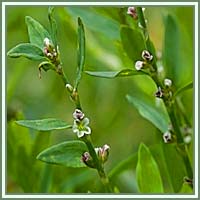KNOTGRASS
Polygonum aviculare
Common name: Knotgrass
Latin name: Polygonum aviculare
Other names: Knotweed, Birdweed, Pigweed, Lowgrass, Centinode, Ninety-knot. Nine-joints, Allseed, Bird’s Tongue, Sparrow Tongue, Red Robin, Armstrong, Cowgrass, Hogweed, Pigrush, Swynel Grass, Swine’s Grass, Wireweed
Family: Polygonaceae
Habitat: Knotgrass can be found on fields and wasteland all around the world
Description: Knotgrass is an annual plant, growing up to 2 meters in height. It has a woody, branched root and much branched stems, varying in size. When it grows on a suitable soil and clear of other vegetation, the stems are prostrate with large leaves; when it grows crowded by other plants, stems are upright and the leaves are smaller. Leaves are arranged alternately, lanceolate or oval, and usually stalkless. Tiny flowers are formed in clusters of two to three, in the axils of the stem. They vary in color: pink, red, green, or pale white. The plant is in flower from May to October.
Parts used: Aerial parts, gathered in summer and dried
Useful components: Tannins, flavonoids, mucilage, coumarins, siic acid, phenolcarboxylic acids
Medicinal use: Knotgrass is considered to be astringent, diuretic, emetic, purgative, vulnerary and styptic. It has been used for centuries in folk medicine for diarrhea, coughs, bronchial catarrh, inflammations of the mouth and upper respiratory tract, liver and kidney disorders. The decoction made from Knotgrass was administered to kill worms. The fresh juice has been used for nose bleed. An ointment made from the plant is an excellent remedy for sores.
Safety: Some herbs could react with certain medication. Therefore it is advisable to contact your doctor/herbalist before consumption of any herb.

